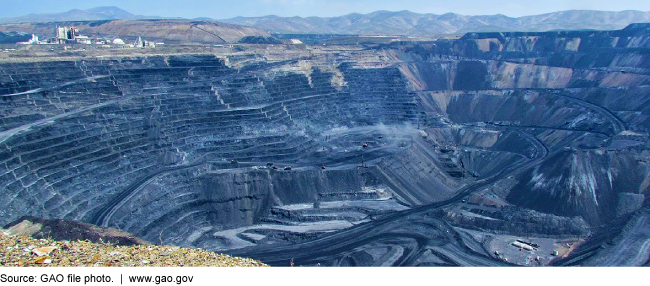Mining on Federal Lands: More Than 800 Operations Authorized to Mine and Total Mineral Production Is Unknown
Fast Facts
Mining on federal lands can produce minerals such as gold, copper, coal, and phosphate. Several laws govern such mining. Depending on the type of federal land and what kind of mineral is produced, mine operators may or may not have to pay the government a royalty.
There are 872 authorized mining operations on about 1.3 million acres of federal land as of September 2018—most of which aren’t subject to royalties.
Mine operators paid about $550 million in royalties in FY 2018. But nobody knows exactly how productive mines on federal lands are, because agencies generally don’t collect data from mine operators that don’t have to pay royalties.
A gold mine on federal lands in Nevada

Gold mine
Highlights
What GAO Found
The Department of the Interior’s Bureau of Land Management (BLM) and the Department of Agriculture’s Forest Service manage federal lands on which mining can occur. Different systems govern mining of solid minerals (such as gold, phosphate, and coal) on federal lands—which consist of public domain lands (those usually never in state or private ownership) and acquired lands (those granted or sold to the United States by a state or citizen):
- Location system. Hardrock minerals (such as gold, silver, and copper) on public domain lands (a majority of federal lands) are managed under the location system. This system allows individuals to locate minerals on public domain lands and stake a claim to obtain the exclusive right to extract those minerals without paying a federal royalty.
- Leasing system. Hardrock minerals on acquired federal lands, non-energy solid minerals (such as phosphate and sodium), and coal are managed under leasing systems. In general, leasing systems allow the federal government to maintain title to the land and establish terms for use of the land, including acreage limitations, and royalty terms.
BLM and Forest Service data showed 872 operations authorized to produce solid minerals on federal lands as of September 30, 2018. Of these mine operations, 83 percent fell under the location system, and the remaining 17 percent of operations were managed using leasing systems. Specifically,
- about 83 percent (728) were authorized to produce locatable hardrock minerals,
- about 2 percent (20) were authorized to produce leasable hardrock minerals,
- about 6 percent (50) were authorized to produce non-energy solid minerals, and
- about 8 percent (74) were authorized to produce coal.
According to agency data, combined, about 1.3 million surface acres of federal lands were associated with operations authorized to produce solid minerals on federal lands. Most authorized coal operations had more than 1,000 associated surface acres per operation. In contrast, most hardrock mineral operations had fewer than 1,000 associated surface acres. A majority of the operations authorized to produce minerals (77 percent) occurred on BLM-managed lands and were located in the western United States. However, most of the leasable hardrock operations authorized for production occurred on Forest Service-managed lands in midwestern and southern states.
In fiscal year 2018, mine operators paid about $550 million in royalties for solid minerals produced under leasing systems. Under the General Mining Act of 1872, locatable hardrock mineral operations are not required to pay federal royalties. In fiscal year 2018, mine operators produced at least 300 million tons of solid minerals under leasing systems. However, GAO previously found that federal agencies generally do not collect data from hardrock mine operators on the amount and value of hardrock minerals extracted from federal lands because there is no federal royalty that would necessitate doing so.
Number of Mine Operations Authorized to Produce Minerals, Number of Operations in Production, and Royalties by Category of Mine Operations, on Federal Lands
|
Category of mine operations |
Number of operations authorized to produce minerals as of Sept. 30, 2018 |
Number of operations in production in fiscal year 2018 |
Production in fiscal year 2018 (tons) |
Federal royalties in fiscal year 2018 (dollars) |
|
Leasable hardrock |
20 |
7 |
143,000 |
8,711,000 |
|
Non-energy solid |
50 |
22 |
11,562,000 |
57,937,000 |
|
Coal |
74 |
43 |
290,000,000 |
480,974,000 |
|
Locatable hardrock |
728 |
Unknown |
Unknown |
0 |
|
Total |
872 |
At least 72 |
At least 301,706,000 |
547,622,000 |
Sources: GAO analysis of data from the Bureau of Land Management, Forest Service, and Office of Natural Resources Revenue. | GAO-20-461R
Note: Data on production and royalties are rounded to the nearest thousand.
Why GAO Did This Study
Solid minerals, such as copper and phosphate, play an important role in the U.S. economy, contributing to multiple industries, including transportation, defense, and aerospace. GAO was asked to review mining on federal lands. This report identifies (1) the number of operations authorized to produce solid minerals on federal lands as of September 30, 2018, and selected characteristics of those operations, and (2) the federal royalties obtained from and quantity of solid minerals produced on federal lands for fiscal year 2018.
GAO analyzed information from BLM and Forest Service data systems on operations those agencies authorized to produce minerals as of September 30, 2018, the most recent data available at the time of GAO’s review. GAO also analyzed revenue and production data from Interior’s Office of Natural Resources Revenue and its Solid Minerals Production and Royalty Reporting System for fiscal year 2018. GAO reviewed agency documents and interviewed BLM and Forest Service officials.
For more information, contact Anne-Marie Fennell at (202) 512-3841 or fennella@gao.gov.
